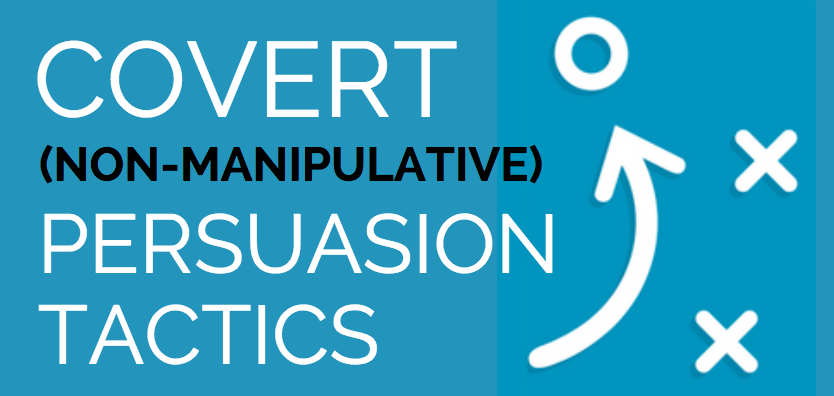Persuasion is a loaded word, isn’t it?
The word itself typically evokes an image of one of two things: a used car salesman who slaps you on the back and pretends to be your best friend… or an intense salary negotiation.
But… Persuasion is a facet of everyday life. Allow me to elaborate. Everything we want in life, from the people to the jobs to the type of restaurant we want for dinner, they won’t be 100% consensuses. People won’t agree with you all the time, and certainly not on things that you want.
Persuasion is the key to anything that isn’t a 100% consensus in your life – which is 99% of the things around you. Essentially, persuasion is the ability to get what you want in life, and occasionally, get others to do what you want as a nice side benefit.
So how can we be persuasive in a subtle way, that takes advantage of natural human psychology, and that doesn’t make us feel sleazy or manipulative? Here are 4 persuasion tactics to influence others in subtle yet effective ways.
Give a Shortcut
You can also call this alluding to others, invoking social proof, or reduce decision fatigue.
What you do is simply talk about other people and how they made the same decision when they were in the other person’s shoes. If you don’t have someone specific, you can feel free to use loose terms such as “many people,” or even make an assumptive statement such as “I’m sure they would…”
“I’m sure they would buy a car if they were you… most people do when they are in your situation!”
When you do this, you’re giving people a shortcut because you’re essentially saying to them “Many other people have looked at this same issue, weighed the pros and cons, and have gone my way. You should too.”
You’re allowing people to piggyback on other people’s alleged decision making and simplify their lives. The more they can relate to the people you allude to, the more powerful this becomes. For example, you’d rather take advice on buying soccer shoes from a soccer player versus someone who hikes a lot.
Ease
Whatever you want to persuade people to do, make sure it’s easy to digest, understand, and as simple as possible. The reason?
We’re lazy. Studies found that people felt far more confident when they had to make two arguments versus six arguments. The difference? The two argument task was far easier for people to do. We want things to be simple and easy, and we trust messages that cater to that.
Conversely, things that appear complex and complicated feel untrustworthy because we can’t understand them immediately, and it’s possible they are hiding something in the complexities. This is the science behind memorable slogans and catch phrases – can you think of any that are longer than three or four words?
Here’s one notable assumption: “If the glove don’t fit, you must acquit!” — but damn, that one is too good.
If you wanted to convince someone to buy a car, don’t show them a series of brochures. Make a short list of four benefits and give them simple points to focus on.
Control the Frame
How would you react if someone tried to argue that the sky was blue because the moon kissed it every morning?
It’s not an argument that remotely makes sense, so you would probably scoff, squint your eyes in a puzzled manner, and be shocked with disbelief that someone would say that.
That’s the frame you’ve created in response to that opposing argument, and that’s the type of frame you should create every time you are opposed. When you can control the frame such that you are above being questioned and above being wrong, you will slowly but surely make people believe what you are saying.
When you control the frame, you inject doubt into other people. The natural line of thinking for them would be, “Wow, he’s really sure about that. Wait… Am I wrong?” Make them questions themselves because your own self-beliefs are so strong and without doubt.
Praeteritio
This is the low road masquerading as the high road.
Praeteritio sounds something like, “I’m not going to do you the indignity of bringing up when you were arrested. You’ve suffered enough from that.”
By virtue of saying that you won’t bring something up, you’ve brought it up. It’s a little sneaky and underhanded, but it also gives you plausible deniability, which means that people won’t be able to call out exactly what you’re doing because you’re phrasing it in a “high road” manner.
When you want to persuade someone, use praeteritio to put people on the defensive subtly. And when people are on the defensive, they won’t be poking holes in whatever your stance is.
For more on getting people to follow you, check out: Persuasion Tactics: Covert Psychology Strategies to Influence, Persuade, and Get Your Way (Without Manipulation).

